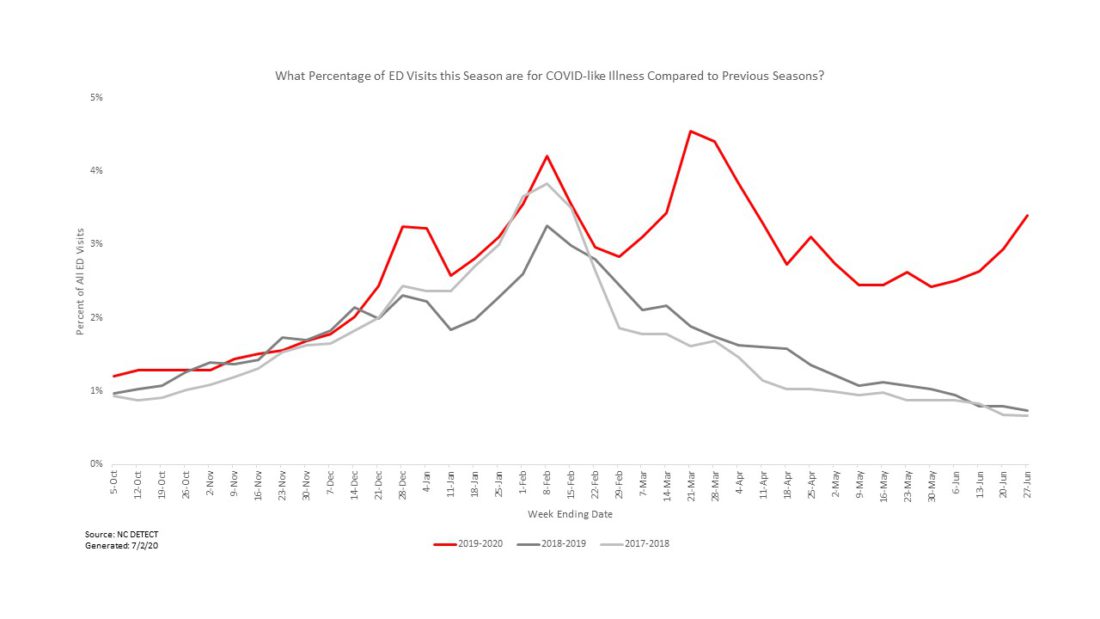North Carolina’s COVID-19 trends continue to move in the wrong direction, according to a July 2 update by Dr. Mandy Cohen, the state’s secretary of health and human services. But in addition to tracking lab-confirmed cases of the disease, NCDHHS is also tracking COVID-like illnesses reported at health care facilities, which can give early warning of subsequent COVID-19 numbers. And emergency department visits for COVID-like illnesses are going up across the state.
NCDHHS employs many of the same systems used to track influenza and other respiratory illnesses to track COVID-like illnesses in emergency departments, hospitals and primary care clinics. Because many symptoms of COVID-19 overlap with influenza symptoms — fever, cough, shortness of breath — officials can compare health care visits by patients with these symptoms between years to estimate COVID-19’s prevalence in the community.
Emergency department visits for COVID-like illness first peaked in early February, which corresponds with seasonal influenza trends in both 2018 and 2019, according to a July 2 report released by NCDHHS. However, during those previous years, visits for respiratory symptoms had decreased to about 1% of all emergency visits by mid-May. At the same time this year, that percentage was about 2.5%; the figure has been climbing steadily since May 30 and exceeded 3% as of June 27, the last point for which data is available.
Broken down to the regional level, emergency department visits for COVID-like illnesses are higher than usual in all parts of North Carolina — except for Western North Carolina. The local percentage has hovered around 1% since the week of April 4 and has not shown a significant uptick in recent weeks.
Personal protective equipment holds steady
On the bright side, North Carolina’s personal protective equipment is holding steady. As of July 6, state stockpiles have enough supplies to fill requests for at least the next three months.
On average, state officials receive requests for about 9,900 N95 respirators and 23,500 procedural masks per day, according to NCDHHS data. At current levels, the state could meet those needs for 495 and 180 days, respectively. Gloves are in highest demand and lowest supply: More than 33,700 gloves are requested daily, with an estimated 84 days of supply on hand.
Gowns, which were previously the most difficult item to procure, are now in abundance. Despite receiving 2.1 million fewer gowns from the federal Strategic National Stockpile than requested, the state currently can fill an estimated 278 days of demand.
In other news
- A Haywood County resident has tested positive for COVID-19 following a trip to Florida, according to a report from the Haywood County Emergency Management Team. As of July 6, NCDHHS reports 106 cases of COVID-19 in the county.
- Henderson County Public Schools is asking for input on the county’s proposed contingency plans for the 2020-21 academic school year. Families are asked to complete the county’s “Return to Learn Family Survey” by 11:59 p.m. on Friday, July 10.
- Asheville and Buncombe County will reinstate parking fees at city- and county-owned parking garages on Saturday, Aug. 1. All parking fees had been temporarily waived to support easy access to downtown businesses since a state of emergency was declared in mid-March.
- The Asheville Outlets and American Red Cross will host a blood drive on Friday, July 24, from 11 a.m.-4 p.m. All blood, plasma and platelet donations will be tested for COVID-19 antibodies.




But who cares? Orange Julius says it will “magically disappear”.
https://www.businessinsider.com/trump-still-believes-coronavirus-will-just-disappear-as-cases-rise-2020-7
So now we’re tracking “covid-like” symptoms to “estimate” community prevalence. Right…